BNP Media Plumbing Group Editorial Director Mike Miazga sat down with Armstrong Fluid Technology Chairman and CEO Charles Armstrong during the 2019 ISH show in Frankfurt. During the chat, Armstrong talked about the family-owned company’s continued evolution, its continued push into international markets and what the future holds for the designer, engineer and manufacturer of intelligent fluid-flow equipment.
pme:: Where do you see Armstrong in today’s marketplace?
CA: The built environment is a key area of focus, helping customers with the abatement of energy use in buildings for HVAC and plumbing systems. We call this energy upgrades. For us, that involves leveraging our capabilities in heat transfer, digitalization, hydraulics and demand-based controls. Applying our core capabilities with integration of advanced technologies in our products, and utilization of the latest communications and analytics infrastructure to define our service delivery, we optimize our offerings to customers that can save a building 50% in energy costs. That’s a big number.
Energy upgrades is a growing marketplace for all of us. The biggest opportunity and the right space for us to be in is helping customers address the mismanagement of the assets in their buildings. We’re excited to move into what we call the “active performance management” arena. In the current environment, a lot of building owners and operators rely on commissioning and recommissioning of mechanical systems, but no one is really doing proper active performance management. That’s where we see an opportunity to make a big difference.
pme: Do you consider Armstrong as being ahead of the technology curve in this industry?
CA: We started with an intelligent pump 19 years ago now. It was a small pump with an integrated drive, developed in conjunction with a European drive manufacturer. Out of that work came the technology for sensorless pumps. In 2004, we included demand-based control and began optimizing cooling systems, using those technologies together, which reduced the energy consumption of those cooling systems.
We started out to change the traditional view of the marketplace. The view of the marketplace had been that energy-efficient solutions would cost more and because of that, most energy efficiency programs would be stopped at a finance director’s desk. We said there is no reason why energy efficiency can’t cost less. It’s been a long journey, but I would say we have been out in front of it and certainly our competitors are now following suit. So, yes, I consider Armstrong Fluid Technology to be a leader in developing and bringing to market energy-efficient solutions.
pme: How important is Armstrong’s push into Europe?
CA: It’s not just Europe, it’s global. Our 50- and 60-cycle products have evolved tremendously over the last 10 years from small shelf products all the way up to 1,200-2,000 HP. Demand-based control or feed-forward control is the correct strategy for a variable-speed system. This is a global push for us. We have participated in Europe through the UK where our biggest presence is, but the rest of Europe is also very important to us, and we are investing on the continent. The price of electricity in Germany is about 2.5 times what it is in North America. Our solutions can save building owners a lot of money, whether they have a green agenda or not.
pme: What’s the difference between a product seller and a solutions provider?
CA: Our job is to make it simple and make these products as plug-and-play as possible. If it’s a complex heating/cooling system, our job is to make solutions that are simple to install, but most importantly, simple to operate.
These pumps will connect to the internet and can be managed through a pump management system, and operate and communicate with each other so they optimize themselves. Human intervention is probably the biggest impediment to reducing building energy costs. With our current technology and services offering, the system will let you know when there’s an issue, so you won’t go months and months or even years and years with these systems operating where they shouldn’t be — not creating comfort and costing huge amounts of money. Of the building systems we get called into, 90% are operating inefficiently, even though the owners have made some attempts to improve efficiency through component upgrades.
pme: What is the significance of being a family-owned company today?
CA: Back in the 1970s, we started recommending the vertical in-line pump instead of horizontal base-mounted. Now there certainly are a lot of vertical pumps in the marketplace. There is a lot of pride involved as a family-owned company. Armstrong has always been forward thinking and innovators. Because we are a family-owned company, we can invest in development for the long-term. A case in point is our Design Envelope technology, developed in 2004 with benefits of lowest installed and lowest total lifecycle cost while providing the greatest energy efficiencies, at a time when total lifecycle cost was not on the radar of the industry. I get a lot of enjoyment out of the business and the people who have taken us to the point where we have made gains in so many areas. We take great pride in creating these points of reference and leading improvements in the industry.
pme: Where does Armstrong head to next?
CA: The organization is in transition at the same time the industry is in transition. There is a tremendous amount of technology being brought forward. For us, it will be a combination of technologies that will make us think differently. We want to be at the heart of integrating those technologies in a meaningful, easy-to-use and intelligent way that doesn’t require human intervention to optimize either fluid flow or system performance. It’s a vision Armstrong has and we hope to contribute to it not only as a company, but as an industry!



